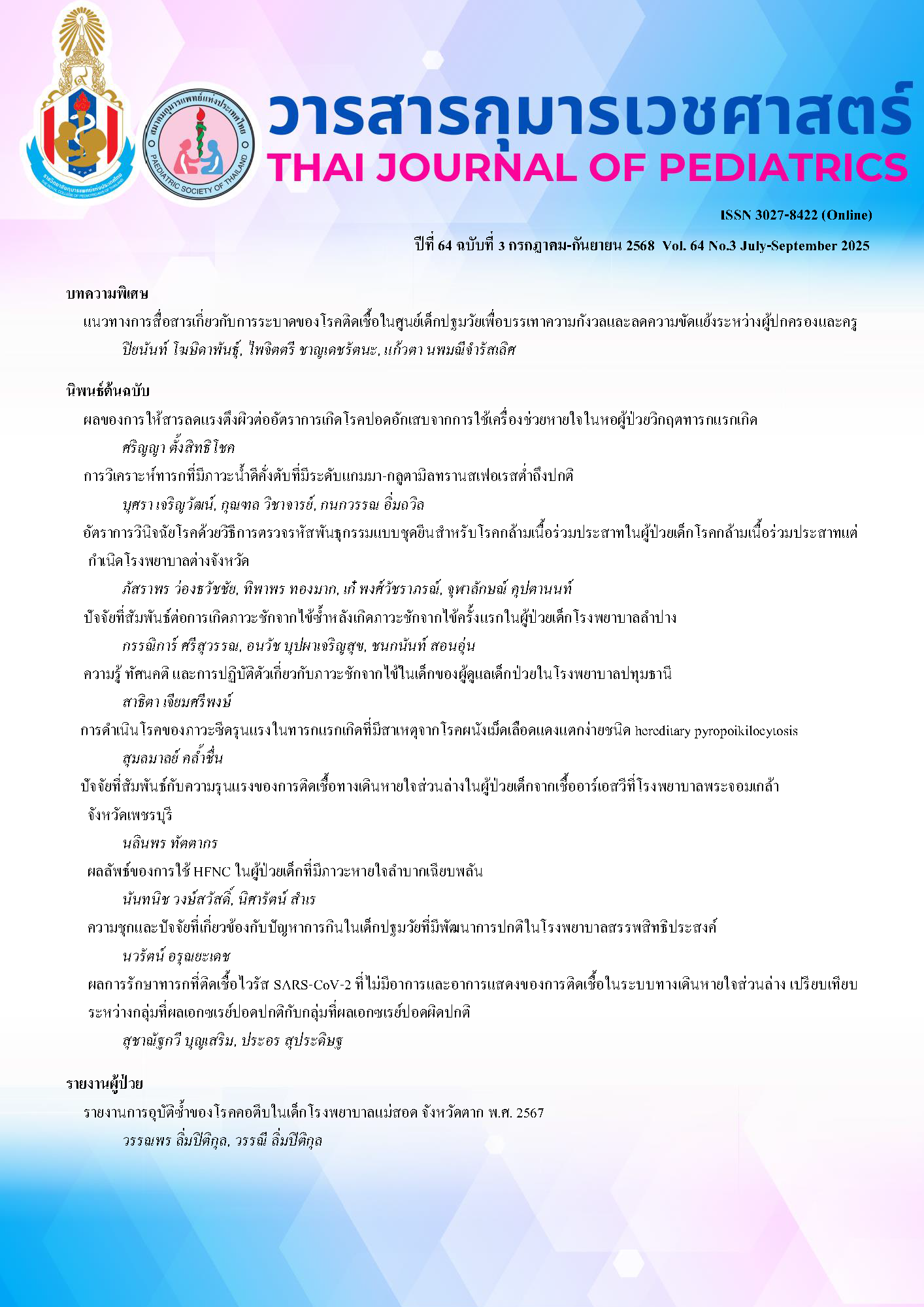ความรู้ ทัศนคติ และการปฏิบัติตัวเกี่ยวกับภาวะชักจากไข้ในเด็กของผู้ดูแลเด็กป่วยในโรงพยาบาลปทุมธานี
คำสำคัญ:
อาการชักจากไข้, ความวิตกกังวล, ผู้ดูแลเด็ก, ความรู้ ทัศนคติ และการปฏิบัติตัว (KAP)บทคัดย่อ
บทนำ: ภาวะชักจากไข้พบได้บ่อยในเด็กอายุ 6 เดือนถึง 5 ปี แม้ส่วนใหญ่เป็นภาวะที่ไม่รุนแรง แต่อาจทำให้ผู้ดูแลเด็กเกิดความวิตกกังวล เนื่องจากความเข้าใจผิดเกี่ยวกับความเสี่ยงต่อความพิการทางสมอง พัฒนาการล่าช้า และโรคลมชัก การปฐมพยาบาลเบื้องต้นที่ไม่เหมาะสมอาจก่อให้เกิดอันตรายแก่เด็กได้
วัตถุประสงค์: เพื่อศึกษาระดับความรู้ ทัศนคติ และการปฏิบัติตัวของผู้ดูแลเด็กเกี่ยวกับอาการชักจากไข้ และวิเคราะห์ปัจจัยที่มีความสัมพันธ์กับความรู้ ทัศนคติ และการปฏิบัติตัว
วิธีการศึกษา: การศึกษาเชิงพรรณนาแบบไปข้างหน้า ที่โรงพยาบาลปทุมธานี ตั้งแต่เดือนกันยายน 2567 ถึงเมษายน 2568 กลุ่มตัวอย่าง คือ ผู้ดูแลเด็ก 478 คน ที่ตอบแบบสอบถาม KAP จำนวน 32 ข้อ
ผลการศึกษา: ส่วนใหญ่เป็นเพศหญิง ร้อยละ 83.7 และเป็นมารดา ร้อยละ 72.4 ผู้ดูแลเด็ก ร้อยละ 59.6 มีคะแนนความรู้ต่ำ ร้อยละ <70 โดยความเข้าใจผิดที่พบบ่อย ได้แก่ การใส่วัตถุในปากระหว่างชัก ร้อยละ 46.5% ความเชื่อว่าอาการชักอาจทำให้พิการหรือเสียชีวิต ร้อยละ 72.6 และเพิ่มความเสี่ยงต่อโรคลมชัก ร้อยละ 68.7 ผู้ดูแลเด็กส่วนใหญ่รู้สึกกังวล ร้อยละ 89.2 แต่มีแนวโน้มปฏิบัติตัวได้ถูกต้อง เช่น ตั้งสติ ร้อยละ 87.8% เช็ดตัวลดไข้ ร้อยละ 85.7 และนำเด็กส่งโรงพยาบาลทันที ร้อยละ 97.2 การวิเคราะห์ถดถอยโลจิสติกพบว่าปัจจัยที่มีผลต่อระดับความรู้ที่ดี เช่น ผู้ป่วยเด็กเป็นบุตรลำดับที่ 4 หรือมากกว่า ผู้ป่วยที่ได้รับการวินิจฉัยภาวะชักจากไข้ ประวัติครอบครัวมีภาวะชักจากไข้ และระดับการศึกษา (ปวช. ปวส. และปริญญาตรี) ปัจจัยที่มีผลต่อทัศนคติเชิงบวกของผู้ดูแลเด็ก คือ ผู้ดูแลเด็กที่มีผู้ป่วยอายุมากกว่า 5 ปี ประวัติภาวะชักจากไข้ (1-3 ครั้ง) และการศึกษาระดับปริญญาตรี ปัจจัยที่มีผลต่อพฤติกรรมที่ดี คือ ผู้ดูแลเด็กที่มีผู้ป่วยเด็กที่ได้รับการวินิจฉัยภาวะชักจากไข้ ความรู้ในระดับดีมีความสัมพันธ์กับทัศนคติที่ดี (OR adjusted = 4.6) และแนวทางการปฏิบัติตัวที่เหมาะสม (OR adjusted = 2.1) อย่างมีนัยสำคัญ
สรุป: ผู้ดูแลเด็กส่วนใหญ่ยังมีความรู้เกี่ยวกับอาการชักจากไข้ที่ไม่เพียงพอและมีความเข้าใจคลาดเคลื่อน ดังนั้นควรส่งเสริมการให้ความรู้เพื่อเพิ่มความเข้าใจที่ถูกต้อง ลดความวิตกกังวล และส่งเสริมการปฏิบัติที่เหมาะสม
Downloads
เอกสารอ้างอิง
Randel A. AAP updates guidelines for evaluating simple febrile seizures in children. Am Fam Physician. 2011;83:1348-50.
Tsubai T. Epidemiology of febrile and afebrile convulsions in children in Japan. Neurology. 1984;34:175-81.
Hackett R, Hackett L, Bhakta P. Febrile seizures in a south Indian district: Incidence and associations. Dev Med Child Neurol. 1997;39:380-4.
Patel N, Ram D, Swiderska N, Mewasingh LD, Newton RW, Offringa M. Febrile seizures. BMJ. 2015;351:h4240.
Srinivasa S, Syeda KA, Patel S, Harish S, Bhavya G. Parental knowledge, attitude, and practices regarding febrile convulsion. Int J Contemp Pediatr. 2018;5:515-9.
Tiwari A, Meshram RJ, Singh RK. Febrile seizures in children: A review. Cureus. 2022;14:e31509.
Veisani Y, Delpisheh A, Sayehmiri K. Familial history and recurrence of febrile seizures: A systematic review and meta-analysis. Iran J Pediatr. 2013;23:389-95.
Commission on epidemiology and prognosis, international league against epilepsy. guidelines for epidemiologic studies on epilepsy. Epilepsia. 1993;34:592-6.
Whelan H, Harmelink M, Chou E, Sallowm D, Khan N, Patil R, et al. Complex febrile seizures: A systematic review. Dis Mon. 2017;63:5-23.
Lee SH, Byeon JH, Kim GH, Eun BL, Eun SH. Epilepsy in children with a history of febrile seizures. Korean J Pediatr. 2016;59:74-9.
Chang YC, Guo NW, Huang CC, Wang ST, Tsai JJ. Neurocognitive attention and behavior outcome of school-age children with a history of febrile convulsions: A population study. Epilepsia. 2000;41:412-20.
Subcommittee on febrile seizures; American academy of pediatrics. Neurodiagnostic evaluation of the child with a simple febrile seizure. Pediatrics. 2011;127:389-94.
Leung AKC, Hon KL, Leung TNH. Febrile seizures: An overview. Drugs Context. 2018;7:212536.
Zeglam AM, Alhmadi S, Beshish A. Auditing the attitude and knowledge of parents of children with febrile seizures. Afr J Neurol Sci. 2010;29:3-8.
Kolahi AA, Tahmooreszadeh S. First febrile convulsions: Inquiry about the knowledge, attitudes and concerns of the patients’ mothers. Eur J Pediatr. 2009;168:167-71.
Shibeeb NF, Altufaily YAS. Parental knowledge and practice regarding febrile seizure in their children. Med J Babylon. 2019;16:58-61.
Almousa A, Alshahrani D, Almubarak MS, Alothman A, Alrashoudi AM, Alsharif A, et al. Parents' knowledge, attitude, and practice regarding febrile convulsion in children in Riyadh, Saudi Arabia. Cureus. 2023;15:e47314.
Sajadi M, Khosravi S. Mothers' experiences about febrile convulsions in their children: A qualitative study. Int J Community Based Nurs Midwifery. 2017;5:284-91.
AlZweihary A, Alkhalifah RS, Alrayes RM. Knowledge, attitude, and practices of parents of children with febrile convulsion in Al-Qassim, Saudi Arabia. Int J Med Dev Ctries. 2021;5:229-36.
Eta EV, Gaelle AN. Knowledge, attitudes and practices of parents regarding convulsion in children under five years in Muea community, Cameroon. Pediatr Neonatal Nurs Open J. 2021;7:13-20.
El Sayed HI. Recognition of parents’ knowledge, attitude and practice regarding febrile seizures in children under five. Am J Nurs Res. 2020;8:72-81.
Krishnan A, Sreeja PA. A prospective study on the assessment of knowledge, attitude and practice of parents regarding febrile seizure. Int Res J Pharm. 2020;11:8-12.
Ng HL, Li H, Jin X, Wong CL. Parental knowledge, attitudes, and practices towards childhood fever among South-East and East Asian parents: A literature review. PLoS One. 2023;18:e0290172.
ดาวน์โหลด
เผยแพร่แล้ว
รูปแบบการอ้างอิง
ฉบับ
ประเภทบทความ
สัญญาอนุญาต
ลิขสิทธิ์ (c) 2025 ราชวิทยาลัยกุมารแพทย์แห่งประเทศไทย และ สมาคมกุมารแพทย์แห่งประเทศไทย

อนุญาตภายใต้เงื่อนไข Creative Commons Attribution-NonCommercial-NoDerivatives 4.0 International License.



